Archive
The Feldberg Art Collection. A Series of Three Exhibitions of European Artworks collected by the Feldberg Family
The Feldberg Art Collection. A Series of Three Exhibitions of European Artworks collected by the Feldberg Family
Word Count: 17
- The Feldberg Art Collection. A Series of Three Exhibitions of European Artworks collected by the Feldberg Family
- Exhibition
- 08-02-1950
- 28-02-1950
In 1950 the Institute of Foreign Languages organised three exhibitions of paintings from the collection of the exiled Jewish manufacturer Siegbert Feldberg and his wife Hildegard from Stettin.
Word Count: 27
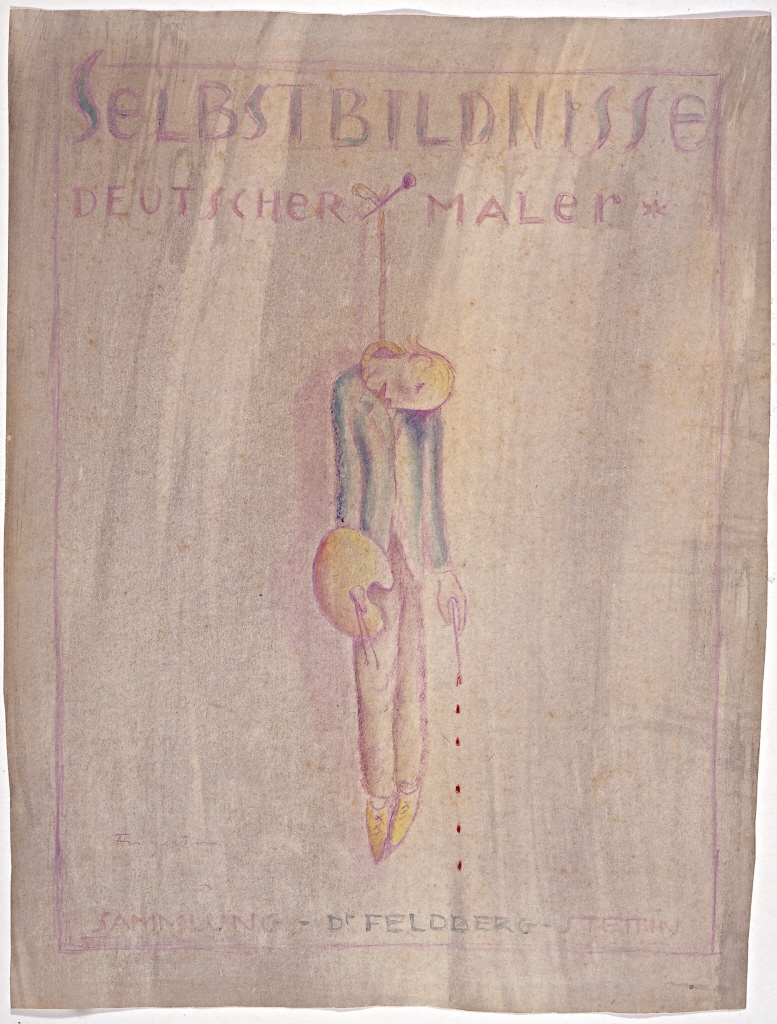
Michel Fingesten, Selbstbildnisse Deutscher Maler – Dr. Siegbert Feldberg Stettin, around 1933, coloured pencil and watercolour on paper, 56,6 x 43,5 cm, Berlin (Courtesy of Berlinische Galerie. Museum für Moderne Kunst). 
Extract from the University of Toronto’s Feldberg Collection 2002 poster; with a collage of the self-portraits from left to right by Josef Oppenheimer, 1933, Friedrich Winkler-Tannenberg, 1930, Conrad Felixmüller, 1929, Willi Jaeckel, 1929 (© Ryan Massiah; All Rights Reserved). 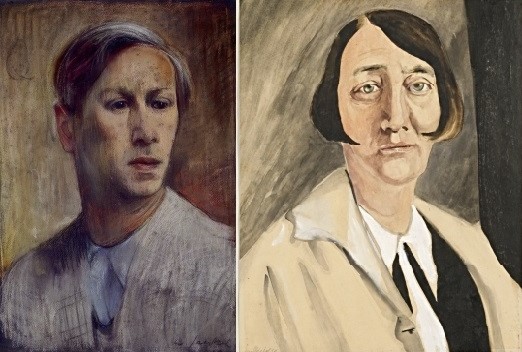
Stylistic variance in the Feldberg Collection. Self-Portrait by Willi Jaeckel (left), 1929, Pastel on black watercolour bütten paper, 51 x 35,5 cm, Berlin. Self-Portrait by Ines Wetzel, 1930, Watercolour, gouache and pencil on drawing cardboard, 47 x 38,4 cm, Berlin (Courtesy of Berlinische Galerie. Museum für Moderne Kunst). 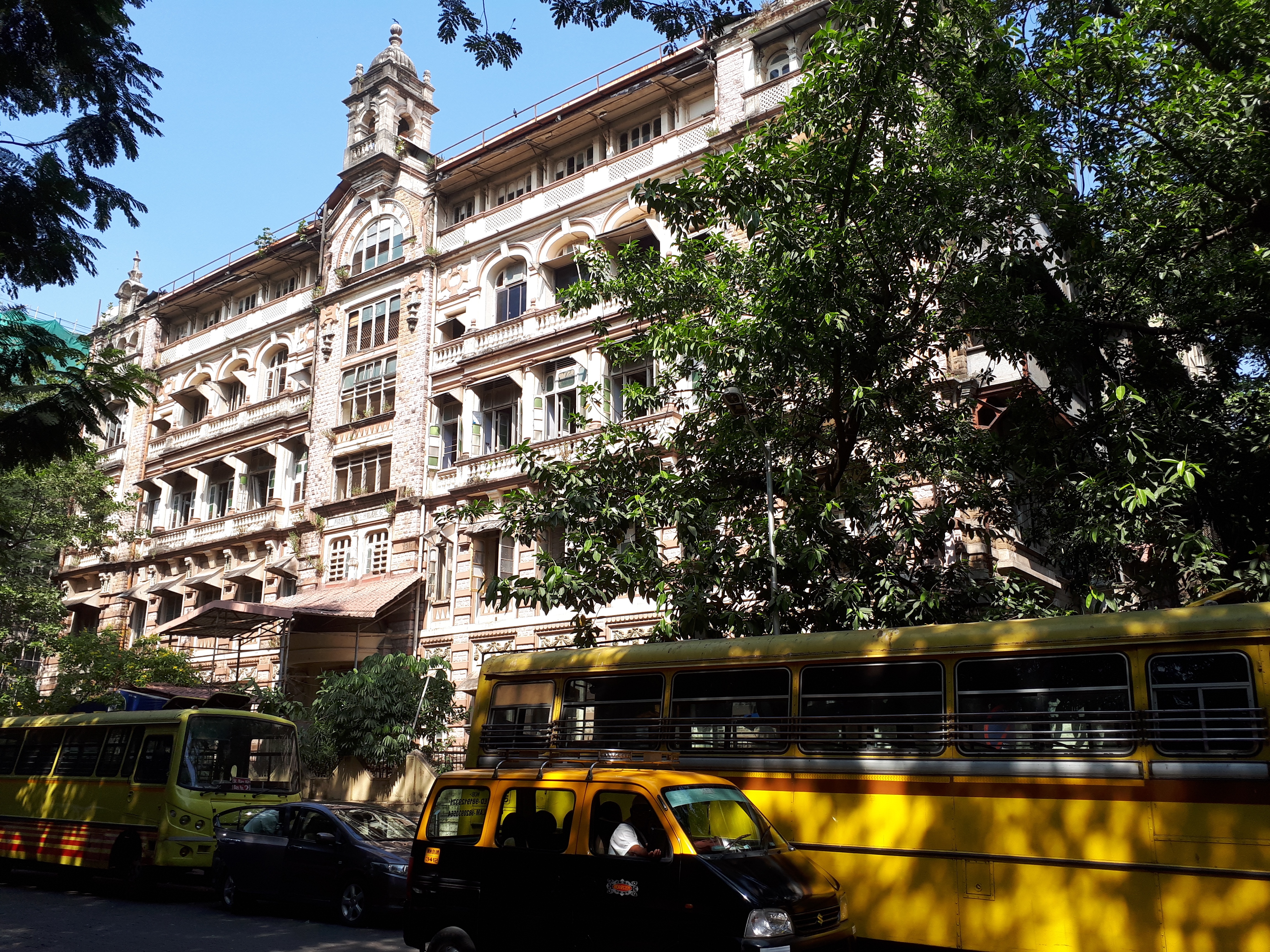
Menkwa Building, Outram Road, site of the three exhibitions of the Feldberg Collection, 2018 (Photo: Margit Franz; All Rights Reserved). 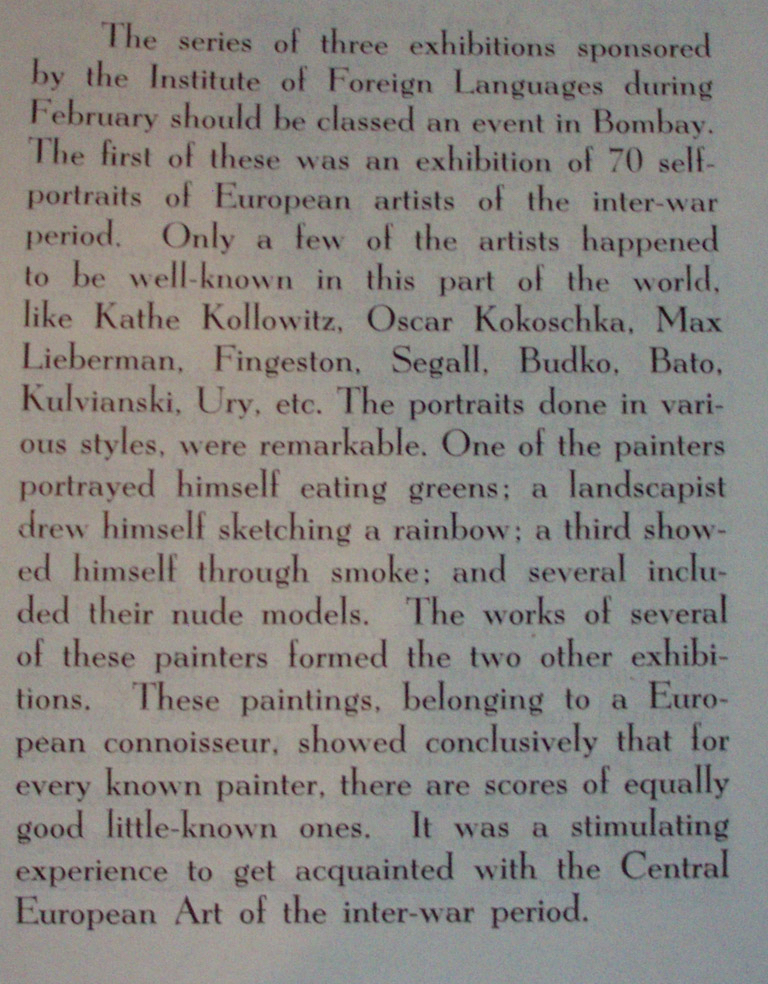
Exhibition review (© Marg, vol. 4, no. 1, 1950, p. 59; reproduced with the permission of The Marg Foundation, Mumbai, India; All Rights Reserved). 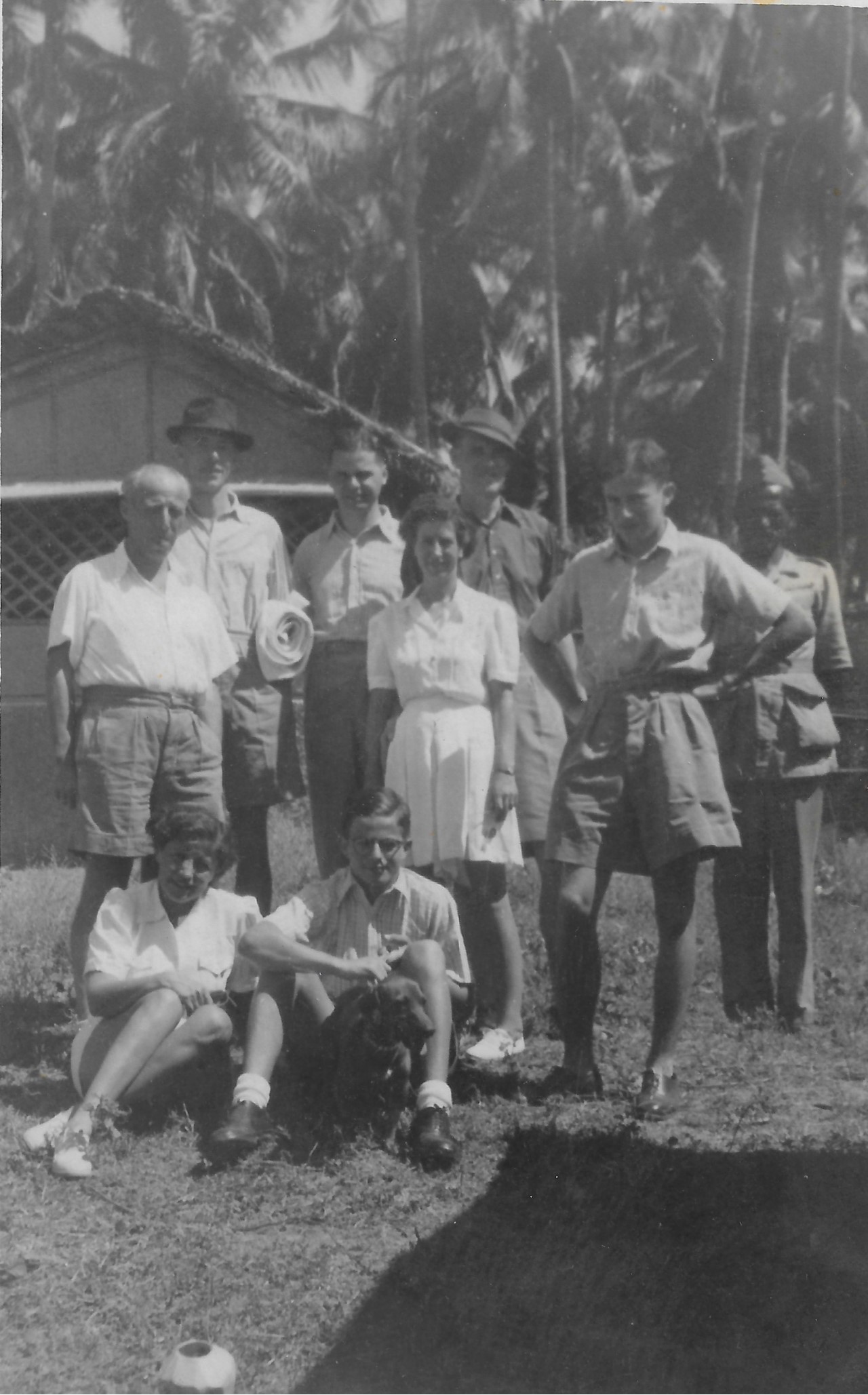
The reunited Feldberg family in India: Siegbert Feldberg (left), Hildegard Feldberg (seated in front of her husband), Heinz Günter Feldberg (with glasses), Hans Jürgen Feldberg (standing next to his seated brother). The other four people are unknown, 1942 or 1943. (© John Feldberg; All Rights Reserved). Anonymous. “Exhibitions: Art Chronicle 1st Quarter 1950.” Marg, vol. 4, no. 1, 1950, p. 59.
Franz, Margit. Gateway India. Deutschsprachiges Exil in Indien zwischen britischer Kolonialherrschaft, Maharadschas und Gandhi. CLIO, 2015. (especially chapter: 6.1. Kunstvermittlung: Das Institute for Foreign Languages von Charles Petras als interkulturelles Kultur- und Kunstzentrum, pp. 248–265. Academia, www.academia.edu/49273939/6_1_Kunstvermittlung_Das_Institute_for_Foreign_Languages_von_Charles_Petras_als_interkulturelles_Kultur_und_Kunstzentrum. Accessed 17 June 2021.)
Franz, Margit. “From Dinner Parties to Galleries: The Langhammer-Leyden-Schlesinger Circle in Bombay – 1940s through the 1950s.” Arrival Cities. Migrating Artists and New Metropolitan Topographies in the 20th Century, edited by Burcu Dogramaci et al., Leuven University Press, 2020, pp. 73–90. Project Muse, doi: 10.1353/book.77990. Accessed 30 March 2021.
Fetthauer, Sophie. “Hilde Feldberg.” LexM – Lexikon verfolgter Musiker und Musikerinnen in der NS-Zeit, edited by Claudia Zenck and Peter Petersen, Universität Hamburg, 2010 [updated 29 March 2017], www.lexm.uni-hamburg.de/object/lexm_lexmperson_00003900. Accessed 14 April 2021.
Georg-Schicht-Preis für das schönste deutsche Frauenporträt, exh. cat. Galerie Gurlitt, Berlin, 1928.
haGalil. “Neue Ausstellung im Jüdischen Museum Berlin: ‘Selbstbildnisse der 20er Jahre. Die Sammlung Feldberg’.” 31 March 2004, haGalil.com: Jüdisches Leben online, www.hagalil.com/archiv/2004/03/feldberg.htm. Accessed 10 March 2021.
Kacprzak, Dariusz. “Kolekcja Feldbergów.” 28 April 2017, Pomeranica.pl, www.pomeranica.pl/wiki/Kolekcja_Feldberg%C3%B3w. Accessed 10 March 2021.
[Leyden, Rudolf von.] “Central European Paintings: Bombay Display.” The Times of India, 9 February 1950, p. 3.
[Leyden, Rudolf von.] “Mixed Fare at Show: Central-European Paintings.” The Times of India, 25 February 1950, p. 8.
McMullen Museum of Art. “Reclaiming a Lost Generation.” McMullen Museum of Art, www.bc.edu/sites/artmuseum/exhibitions/feldberg/. Accessed 10 March 2021.
Mehta, R.N. Genesis and activities of the Museum and Picture Gallery, Vadodara (special issue of Baroda Museum and Picture Gallery: Museum Bulletin, vol. 30). Dep. of Museums, Gujarat State, 1995, p. 34.
Mülhaupt, Freya. “Jüdisches Museum Berlin. Selbstbildnisse der 20er Jahre. Die Sammlung Feldberg.” MuseumsJournal, vol. 18, no. 2, 2004, pp. 51–53.
Nahrwold, Regine. Künstler sehen sich selbst – graphische Selbstbildnisse des 20. Jahrhunderts: Bestandsverzeichnis der Sammlung im Miteigentum des Braunschweigischen Vereinigten Kloster- und Studienfonds (Sammlungskataloge des
Herzog Anton Ulrich-Museums Braunschweig, edited by Jochen
Luckhardt, vol. 8), exh. cat. Herzog-Anton-Ulrich-Museum, Braunschweig, 2000, doi: 10.24355/DBBS.084-201809241208-0. Accessed 5 April 2021.Selbstbildnisse der 20er Jahre. Die Sammlung Feldberg = Self-portraits from the 1920s. The Feldberg Collection, edited by Freya Mülhaupt, exh. cat. Berlinische Galerie – Landesmuseum für Moderne Kunst, Fotografie und Architektur, Berlin, 2004.
Wolff, Larry. “Lost Generation.” Boston College Magazine, Winter 2003, bcm.bc.edu/issues/winter_2003/features_painters.html. Accessed 10 March 2021.
Word Count: 392
Application For Naturalisation from Mr Siegbert Hermann Feldberg Under the British Nationality and Status of Aliens Act 1914 (National Archives of India, New Delhi, 1946), Home Political/E/1946/NA/F-32-74.
Berlinische Galerie, sammlung-online.berlinischegalerie.de/eMP/eMuseumPlus?service=RedirectService&sp=Scollection&sp=SfieldValue&sp=0&sp=3&sp=3&sp=SdetailList&sp=0&sp=Sdetail&sp=0&sp=F. Accessed 10 March 2021.
“Feldberg, Dr. Siegbert”, Lost Art-Datenbank Deutsches Zentrum Kulturgutverluste, Jüdische Sammler und Kunsthändler (Opfer nationalsozialistischer Verfolgung und Enteignung), www.lostart.de/Content/051_ProvenienzRaubkunst/DE/Sammler/F/Feldberg,%20Dr.%20Siegbert.html?cms_lv2=5664&cms_lv3=8706. Accessed 10 March 2021.Word Count: 103
Menkwa Building, Outram Road, Fort, Bombay (now Buddha Bhavan, Purshotamdas Thakurdas Marg, Fort, Mumbai).
- Bombay
- Margit Franz; Mareike Schwarz. "The Feldberg Art Collection. A Series of Three Exhibitions of European Artworks collected by the Feldberg Family." METROMOD Archive, 2021, https://archive.metromod.net/viewer.p/69/2951/object/5141-11946865, last modified: 14-09-2021.
-
Institute of Foreign LanguagesLanguage SchoolExhibition SpaceLibraryTheatreBombay
With its wide range of cultural activities, the Institute of Foreign Languages − founded in 1946 by the Viennese emigrant Charles Petras − became a glocal contact zone in Bombay.
Word Count: 27
Rudolf von LeydenGeologistAdvertisement SpecialistJournalistArt CriticArt CollectorCartoonistBombayThe advertisement expert, Rudolf von Leyden, became a major art critic and art historian in Bombay in the 1940s, advocating an urgent need for modernism in art in post-colonial India.
Word Count: 30
Marg. A Magazine of Architecture and ArtMagazineBombayLocal and exiled creatives formed the Modern Architectural Research Group to publish a progressive journal of art and architecture in Bombay from 1946 onwards.
Word Count: 23
Exhibition of prints by Käthe KollwitzExhibitionShanghaiA German woodcut exhibition organised at the Zeitgeist Bookstore presumably took place in June 1931. In June 1932. A further exhibition with more than 200 works by German artists, including works by Käthe Kollwitz and George Grosz, was shown at the Chinese Y.M.C.A.
Word Count: 44
Open Studio Evenings by Käthe and Walter LanghammerSalonBombayThe painter Walter Langhammer and his wife Käthe built an informal infrastructure to promote local avant-garde artists and regularly invited them to Open Studio Evenings at their studio.
Word Count: 29